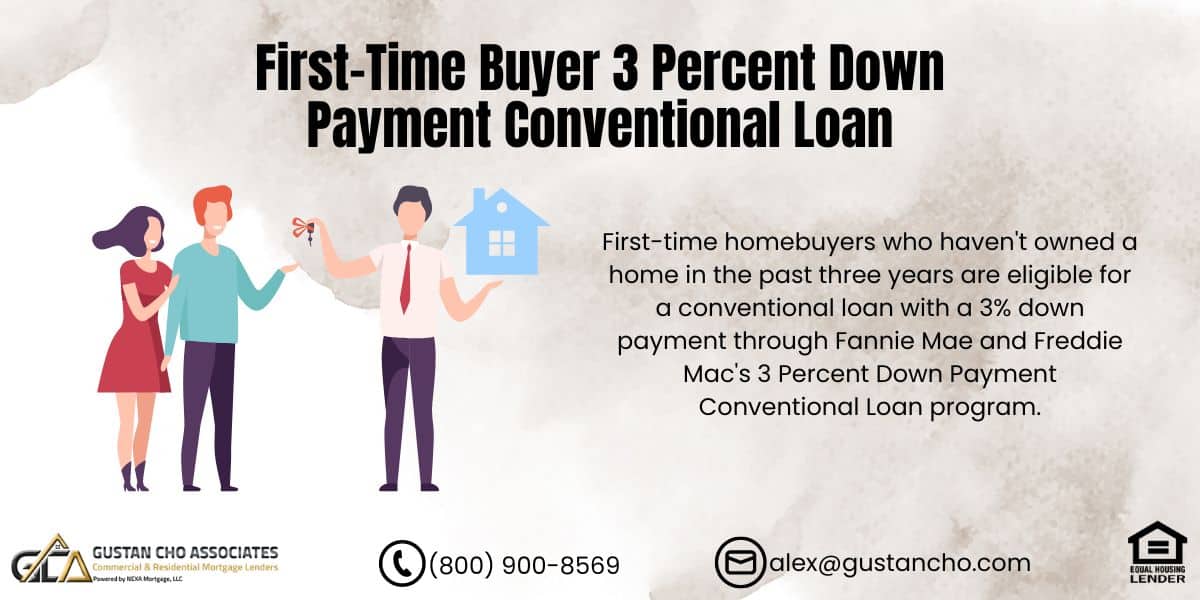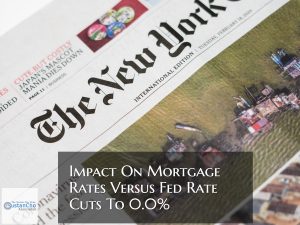This guide covers Fannie Mae and Freddie Mac’s percent down payment conventional loan program for first-time homebuyers. Fannie Mae and Freddie Mac’s mission is to purchase mortgage loans from banks and lenders and promote homeownership.
Fannie and Freddie want to make homeownership accessible to the average hard-working family with access to credit for homebuyers, especially first-time home buyers. The 3 percent down payment conventional loan program was re-launched by the Federal Housing Finance Agency (FHFA) to compete with HUD’s 3.5% down payment FHA loans.
Can You Do 3% Down on a Conventional Loan?
First-time homebuyers who haven’t owned a home in the past three years are eligible for a conventional loan with a 3% down payment through Fannie Mae and Freddie Mac’s 3 Percent Down Payment Conventional Loan program.
This initiative, known as the 97 LTV Conventional loan program, specifically targets the challenge of accumulating the required down payment for many prospective homeowners.
Despite their ability to manage monthly mortgage payments and other debts, the upfront costs, including the down payment and closing expenses, remain a significant hurdle due to the high cost of living. Click here to get 3% down on a conventional loans
Down Payment Requirements On Conforming Loans
The good news is that Fannie Mae and Freddie Mac introduced the 3 Percent Down Payment Conventional Loan program for first-time homebuyers. This program, which was highly popular among first-time homebuyers, required only a 3 percent down payment. However, Fannie Mae and Freddie Mac discontinued this program in 2014.
A minimum 5 percent down payment is typically required to qualify for a conventional loan. It is still possible for homebuyers with a 3 percent down payment to be eligible for a conventional loan, provided that they fulfill the conventional lending criteria.
Is 3% Enough for a Down Payment?
A 3% down payment is typically sufficient for a conventional loan, especially if you consider conforming to loan limits. Various conventional loan programs, such as those backed by Fannie Mae or Freddie Mac, often allow for down payments as low as 3%. However, it’s crucial to consider several factors that can influence this.
Firstly, you may need to pay for private mortgage insurance (PMI) with a down payment below 20%, which increases your monthly costs until you reach 20% equity in the home. Additionally, your credit score and debt-to-income ratio (DTI) can impact the terms of your loan, potentially affecting the required down payment.
Consulting with a mortgage lender is recommended to understand your options clearly based on your financial profile and the available loan programs.
What is the Maximum DTI for a Conventional Loan?
The maximum debt-to-income (DTI) ratio for a conventional loan typically depends on several factors, including the specific loan program, the lender’s requirements, and your overall financial profile. However, as a general guideline:
- Conforming Conventional Loans: These loans follow Fannie Mae and Freddie Mac’s guidelines. The maximum DTI ratio for these loans is usually from 43% to 50%. Still, some lenders may allow higher DTIs if there are compensating factors.
- Non-Conforming Conventional Loans: These are often called jumbo loans and exceed the conforming loan limits set by Fannie Mae and Freddie Mac. Lenders for these loans may have different DTI requirements, often stricter than those for conforming loans.
- Automated Underwriting Systems: Many lenders utilize desktop underwriting systems to evaluate loan applications, such as Desktop Underwriter (DU) or Loan Prospector (LP). If credit scores and financial reserves are strong, these systems may approve higher DTIs.
- Manual Underwriting: In some cases, if your application doesn’t fit within automated underwriting guidelines, a lender may manually underwrite the loan. This can allow for more flexibility in DTI ratios, especially if you have compensating factors such as a large down payment or substantial cash reserves.
It’s essential to note that while these are general guidelines, individual lenders may have their own overlays and requirements, which can vary. Therefore, it’s best to discuss your situation with a mortgage lender to understand the maximum DTI ratio you can qualify for based on the loan program and the lender’s criteria. Click here to apply for a conventional loans
Home Possible Advantage By Freddie Mac
Freddie Mac’s Home Possible Advantage program is offered to first-time home buyers in a housing counseling program. It needs to be single-family and primary residential units only. Mortgage insurance is mandatory. On refinance conventional loans, no cash-out refinance is allowed.
Fannie Mae 3 Percent Down Payment Conventional Loan

Fannie Mae’s 3 percent down payment conventional loan program is available for first-time homebuyers only. It is also available for homebuyers who have not owned a primary property in the past three years. No housing counseling is required like Freddie Mac except for the My Community Mortgage home purchases. The 3% down payment conventional loan program is only available for owner-occupant primary homes, and private mortgage insurance is mandatory.
Reasons Why Homebuyers Need To Go With Conventional Versus FHA Loans
Fannie Mae has already launched the 3 percent down payment conventional loan program on December 13, 2014. Freddie Mac launched the 3 percent down payment conventional loan program on March 23, 2015. Sometimes, homebuyers can only qualify for conventional loans, not FHA loans—large outstanding student loan balances.
Conventional and FHA loans accept Income-Based Repayment (IBR) payments. HUD now accepts income-based repayment. If a borrower has $200,000 in outstanding student loans and an IBR payment that reports on credit bureaus is $80.00 monthly, that monthly IBR payment is used.
Conventional and FHA loans now accept income-based payments for debt-to-income ratio calculations. Fannie Mae, Freddie Mac, and HUD all take 0.5% of the outstanding student loan balance and use it as a hypothetical debt for debt-to-income ratio calculations on deferred student loans. The 0.50% of the outstanding student loan balance is used as a hypothetical debt.
What is a Conventional 97 Loan?
Conventional 97 loan is a Fannie Mae program to help first-time homebuyers. A down payment as low as 3% of the home’s purchase price is allowed. An attractive option for those who cannot afford a larger down payment. With a Conventional 97 loan, borrowers must pay for private mortgage insurance (PMI).
The costs are typically lower than other low-down-payment loan programs like FHA loans. To qualify, borrowers need a credit score 620, meet standard criteria for income, work history, and debts, and buy a one-unit primary residence. The Conventional 97 loan offers the advantage of a low down payment while providing flexibility regarding property types and loan features.
However, borrowers should consider ongoing PMI costs and other financial factors before choosing this mortgage option. Consulting with a mortgage lender can help determine if the Conventional 97 loan is right based on individual financial circumstances.
Mortgage Included In Chapter 7 Bankruptcy
For borrowers with a mortgage included in Chapter 7 Bankruptcy, there is a four-year waiting period to qualify for conventional loans from the discharge date of Chapter 7. The housing event needs to have been finalized. The recorded date of the housing event (foreclosure, deed-in-lieu of foreclosure, short sale) does not matter.
The mortgage cannot be reformed after Chapter 7 Bankruptcy. With FHA Loans, there is a three-year waiting period after the recorded date of the housing event, and the discharge date of Chapter 7 Bankruptcy does not matter.
Buying High-Priced Homes
Homebuyers of higher-priced homes must consider government and conventional loans with maximum loan limits, except VA loans. FHA loan limits in 2023 are capped at $472,030 in regular areas and $1,089,300 in high-cost counties on single-family homes. Conventional loan limits are capped at $726,200 in regular areas and $1,089.300 in high-cost counties on single-family homes.
Any loan limit higher than the conforming or FHA loan limit caps are called non-conforming loans or jumbo loans. Homebuyers need to put additional down payment above the maximum loan limit or get a piggy back second mortgage. If not, homebuyers of high-priced homes need to get jumbo loans versus traditional conforming or FHA loans.
Homebuyers of higher-priced homes are forced to qualify with conventional loans versus FHA loans due to the higher loan limits. Borrowers who need to qualify for a mortgage with a direct lender with no mortgage overlays on government and conventional loans, please contact us at Gustan Cho Associates Mortgage Group at 800-900-8569 or text us for a faster response. Or email us at gcho@gustancho.com. The Team at Gustan Cho Associates is available seven days a week, evenings, weekends, and holidays. Click here to apply for a conventional loans in chapter 7 bankruptcy
FAQ: First-Time Buyer 3 Percent Down Payment Conventional Loan
1. What is the Conventional 97 loan program? Fannie Mae & Freddie Mac’s Conventional 97 loan lets first-time homebuyers qualify for a conventional loan with only a 3% down payment.
2. Who qualifies as a first-time homebuyer? Individuals who have not owned a home for the past three years are considered first-time homebuyers. This definition encompasses people who have never owned a home before and those who haven’t recently owned one.
3. Are there income limits for the Conventional 97 loan program? There are no specific income limits for the Conventional 97 loan program. However, borrowers must meet standard underwriting criteria regarding income, employment history, and debt-to-income ratio.
4. What are the advantages of the Conventional 97 loan program? The Conventional 97 loan program offers the advantage of a low down payment, making homeownership more accessible to first-time buyers. Private mortgage insurance (PMI) costs are typically lower than other low-down-payment loan programs.
5. How does the Conventional 97 loan program compare to FHA loans?FHA loans require a 3.5% down payment, while the Conventional 97 program requires 3%. Remember that FHA loans have specific eligibility criteria and insurance requirements that differ from conventional loans.
6. What is a conventional loan’s maximum debt-to-income (DTI) ratio? The maximum DTI ratio allowed for a loan depends on the specific program and lender requirements. Generally, conforming conventional loans have maximum DTI ratios ranging from 43% to 50%. However, non-conforming loans may have stricter DTI requirements.
7. Can borrowers with outstanding student loans qualify for the Conventional 97 loan program? Yes, borrowers with outstanding student loans can qualify for the Conventional 97 loan program. Fannie Mae and Freddie Mac consider income-based repayment (IBR) plans and calculate a hypothetical debt for debt-to-income ratio calculations.
8. What are the homeownership counseling requirements for the Conventional 97 loan program? While homeownership counseling may not be mandatory for the Conventional 97 loan program, some lenders or specific loan products within the program may require housing counseling for first-time homebuyers.
9. Is the Conventional 97 loan program available for investment properties or second homes? The Conventional 97 loan program is intended solely for primary residences occupied by their owners. It does not apply to investment properties or secondary homes.
This blog about First-Time Buyer 3 Percent Down Payment Conventional Loan was updated on April 9th, 2024.
Click here to get 3% down on a conventional loans








